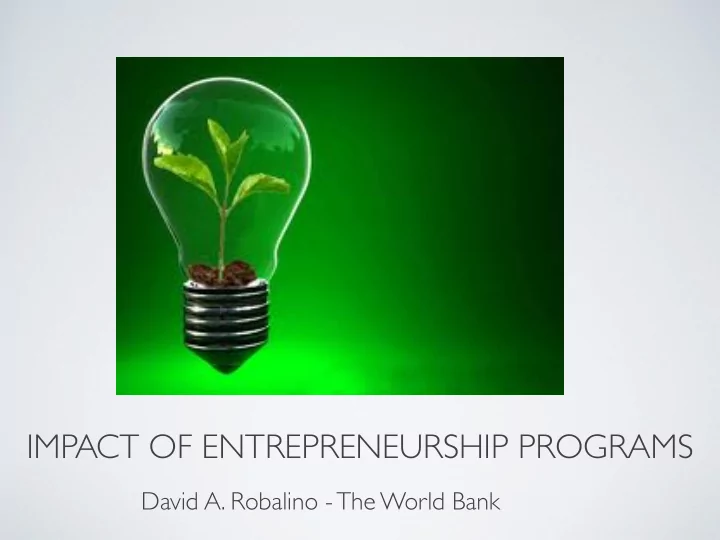

IMPACT OF ENTREPRENEURSHIP PROGRAMS David A. Robalino - The World Bank
% UNSUCCESFUL ENTREPRENEURS Non-Agr Agriculture All East Asia Eastern Europe Latin America Middle East and North Africa South Asia SS Africa 0 22.5 45 67.5
ROLE OF THE PROGRAMS • Facilitate "entrance" • Increase productivity of current, economically viable, activities • Facilitate transitions from low to high productivity activities
CONSTRAINTS AND PROGRAMS Training (technical, business K, life skills) SKILLS (T, C, NC) Advisory services / networking INFORMATION Credit, grants, insurance FINANCING Integration into value chains BARRIERS TO ENTRY BUSINESS ENV. Changes in regulations / infrastructure
WHAT DO WE SEE? Effects on Labor Market Activity • Small scale pilots; few evaluations Positive effects • It is easier to change behaviors (e.g., savings, books) and attitudes • Poor results for stand alone No Effects micro-finance programs • Finance + training works better Negative effects • But it is difficult to identify what makes a program successful 0 15 30 45 60
THE META-ANALYSIS (BASED on Yoon Choo and Maddalena Honorati 2013)
38 STUDIES • Focus on current or potential "entrepreneurs" • Rigorous experimental or quazi experimental evaluations (control vs. treatment groups) • Evaluations conducted over the last10 years in developing countries • Results in public domain (published by March 2012)
PROGRAMS • TRAINING: technical, life skills, business & financial management • FINANCE: credit, grants, savings, insurance • TRAINING + FINANCE
OUTCOMES EMPLOYMENT Positive EARNINGS Impact BUSINESS PRACTICE BUSINESS PERFORMANCE Size effect FINANCIAL KNOWLEDGE ATTITUDES
CONTROLS POPULATION Female, youth, safety nets beneficiary, GROUPS MFI client, business owner SERVICE Government, NGO, University, MFI DELIVERY Region, income, labor market conditions, CONTEXT business environment
DISTRIBUTION OF PROGRAMS EAP 11% SAR 27% SSA 24% MENA LAC ECA 5% 27% 6%
TYPES OF PROGRAMS BY INCOME LEVEL Training Financing Both 100 75 50 25 0 Low income Lower middle Upper middle
AVERAGE SIZE EFFECTS Training Finance Both Employment Earnings Business K Business practice Financial K Attitudes 0 0.075 0.15 0.225 0.3
12.00 Positive and Statistically Significative 7.50 T-statistic 3.00 -1.50 -6.00 -0.450 -0.225 0.000 0.225 0.450 0.675 0.900 Diferencia entre grupo de tratamiento y control (puntos porcentuales)
CORRELATES OF POSITIVE OUTCOMES Business K Attitudes Youth Higher Edu Benef Micro Experimental Upper MI -0.8 -0.6 -0.4 -0.2 0 0.2 0.4 0.6 0.8
DETERMINANTS OF CHANGES IN EMPLOYMENT Training only Finance only Youth Business owner Urban # Months Experimental -0.3 -0.225 -0.15 -0.075 0 0.075 0.15
DETERMINANTS OF CHANGES IN EARNINGS Training only Higher Edu Beneficiary SA Urban # Months Experimental -0.068 -0.045 -0.023 0 0.023 0.045 0.068 0.09
WHAT ABOUT THE TYPE OF TRAINING? • Financial training (-) • Technical (+) • Life skills + business (++) • Life skills + technical (++) • Duration (+++)
WHAT ABOUT CONTEXT? • Few significant interactions • High youth unemployment (+) • Weak business environment (+) • Conflict (+)
SOME PROMISING INTERVENTIONS • Northern Uganda Social Action Fund (life skills and technical training + grant) increased hours work by 30% and earnings by 50% • Peru's Progama de Calificacion de Jovenes Emprendedores (business plan support, training, mentorships, credit) increased earnings by 40%, firms survival by 40% and employment by 17% • Preliminary results for Adolescent Girls Initiative are also promising (e.g., Liberia) • Colombia Alianza Productiva
ISSUES WITH DESIGN • Develop tools to distinguish between two groups: gazelles and subsistence • "True" entrepreneurs might do fine with traditional support (training , advisory services, finance) • For subsistence entrepreneurs more involved, comprehensive interventions would be required that rely on "external agents:" • Regional focus (rural) • Agents analyze local conditions and business opportunities including integration with and movement up value chains • They organize producers, train, and manage daily activities • Address local constraints to entrepreneurial activity (basic infrastructure)
TAKE AWAYS • Programs are important • Results have been mixed • Need to better understand the constraints ("gazelles" vs subsistence entrepreneurs) • Target integrated services • Pilot and evaluate
Recommend
More recommend